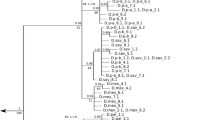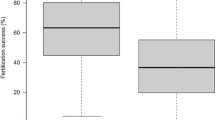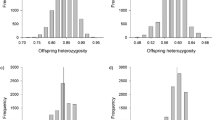Abstract
Divergence at gamete recognition loci is hypothesized to result in speciation in broadcast spawning invertebrates. Many gamete recognition loci evolve quickly and show patterns of positive selection, yet the advantage of divergence is rarely known. M7 lysin is a sperm protein in the Mytilus edulis species complex that shows evidence of adaptive evolution. This locus is polymorphic with two distinct clades within Mytilus galloprovincialis, one of which, the D clade, shows the strongest signal of positive selection. We tested whether the geographic patterns in allele frequency were consistent with the hypothesis that positive selection on D clade alleles (G D ) was due to reinforcement. Populations of M. edulis showed little evidence of introgression of G D alleles, but there was no consistent evidence of reproductive character displacement. The lack of consistent patterns expected of reinforcement suggests that another mechanism is likely responsible for the adaptive divergence of M7 lysin.



Similar content being viewed by others
References
Barton NH, Hewitt GM (1985) Analysis of hybrid zones. Ann Rev Ecol Syst 16:113–148
Bierne N, David P, Langlade A, Bonhomme F (2002) Can habitat specialization maintain a mosaic hybrid zone in marine bivalves? Mar Ecol Prog Ser 245:157–170
Bierne N, Bonhomme F, Boudry P, Szulkin M, David P (2006) Fitness landscapes support the dominance theory of post-zygotic isolation in the mussels M. edulis and M. galloprovicialis. Proc R Soc B 273:1253–1260
Brannock PM, Wethey DS, Hilbish TJ (2009) Extensive hybridization with minimal introgression in Mytilus galloprovincialis and M. trossulus in Hokkaido, Japan. Mar Ecol Prog Ser 383:161–171
Carney SE, Hodges SA, Arnold ML (1996) Effect of differential pollen-tube growth on hybridization in the Louisiana irises. Evolution 50:1871–1878
Chapman MA, Forbes DG, Abbot RJ (2005) Pollen competition among two species of Senecio (Asteraceae) that form a hybrid zone on Mt. Etna, Sicily. Am J Bot 92:730–735
Coustau C, Renaud F, Delay B (1991) Genetic characterization of the hybridization between M. edulis and M. galloprovincialis on the Atlantic coast of France. Mar Biol 11:87–93
Coyne JA, Orr HA (2004) Speciation. Sinauer Associates, Inc., Sunderland
Daguin C, Borsa P (1999) Genetic characterization of Mytilus galloprovincialis Lmk. In North West Africa using nuclear DNA markers. J Exp Mar Biol Ecol 235:55–65
Diaz A, Macnair MR (1999) Pollen tube competition as a mechanism of prezygotic reproductive isolation between Mimulus nasutus and its presumed progenitor M. guttatus. New Phytol 144:471–478
Emms SK, Hodges SA, Arnold ML (1996) Pollen-tube competition, siring success, and consistent asymmetric hybridization in Louisiana irises. Evolution 50:2201–2206
Faure MF, David P, Bonhomme F, Bierne N (2008) Genetic hitchhiking in a subdivided population of Mytilus edulis. BMC Evol Biol 8:164
Gardner JPA, Skibinski DOF, Bajdik CD (1993) Shell growth and viability differences between the marine mussels Mytilus edulis (L.), Mytilus galloprovincialis (Lmk.), and their hybrids from two sympatric populations in S.W England. Biol Bull 185:405–416
Geyer LB, Palumbi SR (2003) Reproductive character displacement and the genetics of gamete recognition in tropical sea urchins. Evolution 57:1049–1060
Geyer LB, Palumbi SR (2004) Conspecific sperm precedence in two species of tropical sea urchins. Evolution 59:97–105
Gosling EM (1992) Systematics and geographic distribution of Mytilus. In: Gosling EM (ed) The mussel Mytilus: ecology, physiology, genetics, and culture. Elsevier Science, Amsterdam, pp 1–20
Hellberg ME, Vacquier VD (1999) Rapid evolution of fertilization selectivity and lysin cDNA sequences in teguline gastropods. Mol Biol Evol 16:839–848
Heß A-K, Bartel M, Roth K, Messerschmidt K, Heilmann K, Kenchington E, Micheel B, Stuckas H (2012) Expression of M6 and M7 lysin in Mytilus edulis is not restricted to sperm, but occurs also in oocytes and somatic tissue of males and females. Mol Reprod Dev 79:517–524
Hilbish TJ, Carson EW, Plante JR, Weaver LA, Gilg MR (2002) Distribution of Mytilus edulis, M. galloprovincialis, and their hybrids in open-coast populations of mussels in southwestern England. Mar Biol 140:137–142
Howard DJ (1993) Reinforcement: origin, dynamics, and fate of an evolutionary hypothesis. In: Hybrid Zones and the evolutionary process. Oxford university press, New York
Howard DJ (1999) Conspecific sperm and pollen precedence and speciation. Ann Rev Ecol Syst 30:109–132
Howard DJ, Gregory PG, Chu J, Cain ML (1998) Conspecific sperm precedence is an effective barrier to hybridization between closely related species. Evolution 52:511–516
Inoue K, Waite JH, Matsuoka M, Odo S, Harayama S (1995) Interspecific variations in adhesive protein sequences of Mytilus edulis, M. galloprovincialis, and M. trossulus. Biol Bull 189:370–375
Kijewski T, Smietanka B, Zbawicka M, Gosling E, Hummel H, Wenne R (2011) Distribution of Mytilus taxa in European coastal areas as inferred from molecular markers. J Sea Res 65:224–234
Kresge N, Vacquier VD, Stout CD (2000) Abalone lysin: the dissolving and evolving sperm protein. BioEssays 23:95–103
Levitan DR, Ferrel DL (2006) Selection on gamete recognition proteins depends on sex, density, and genotype frequency. Science 312:267–269
Levitan DR, Strapper AP (2010) Simultaneous positive and negative frequency dependent selection on sperm bind in, a gamete recognition protein in the sea urchin Strongylocentrotus purpuratus. Evolution 64:785–797
McCartney MA, Lima TG (2011) Evolutionary consequences of introgression at M7 lysin, a gamete recognition locus, following secondary contact between a blue mussel species. Integr Comp Biol 51:474–484
Palumbi SR (1994) Genetic divergence, reproductive isolation, and marine speciation. Ann Rev Ecol Syst 25:547–572
Palumbi SR (2009) Speciation and the evolution of gamete recognition genes: pattern and process. Heredity 102:66–76
Price CSC (1997) Conspecific sperm precedence in Drosophila. Nature 388:663–666
Quesada H, Beynom CM, Skibinski DO (1995) A mitochondrial DNA discontinuity in the mussel Mytilus galloprovincialis Lmk: pleistocene vicariance biogeography and secondary intergradation. Mol Biol Evol 12:521–524
Ramsey J, Bradshaw HD Jr, Schemske DW (2003) Components of reproductive isolation between the monkeyflowers Mimulus lewisii and M. cardinalis (Phrymaceae). Evolution 57:1520–1534
Rawson PD, Joyner KL, Meetze K, Hilbish TJ (1996) Evidence for intragenic recombination within a novel genetic marker that distinguishes mussels in the Mytilus edulis species complex. Heredity 77:599–607
Rawson PD, Hayhurst S, Vanscoyoc B (2001) Species composition of blue mussel populations in the northeastern Gulf of Maine. J Shellfish Res 20:31–38
Rawson PD, Slaughter C, Yund PO (2003) Patterns of gamete incompatibility between the blue mussels Mytilus edulis and M. trossulus. Mar Biol 143:317–325
Raymond M, Rousset F (1995) Genepop (version 1.2): population genetics software for exact tests and ecumenicism. J Heredity 86:248–249
Rieseberg LH, Desrochers AM, Youn SJ (1995) Interspecific pollen competition as a reproductive barrier between sympatric species of Helianthus (Asteraceae). Am J Bot 82:515–519
Riginos C, Cunningham CW (2005) Local adaptation and species segregation in two mussel (Mytilus edulis x Mytilus trossulus) hybrid zones. Mol Ecol 14:381–400
Riginos C, McDonald JH (2003) Positive selection on an acrosomal sperm protein, M7 lysin, in three species of the mussel genus Mytilus. Mol Biol Evol 20:200–207
Riginos C, Sukhdeo K, Cunningham CW (2002) Evidence for selection at multiple allozyme loci across a mussel hybrid zone. Mol Biol Evol 19:347–351
Riginos C, Wang D, Abrams AJ (2006) Geographic variation and positive selection on M7 lysin, an acrosomal sperm protein in mussels (Mytilus spp.). Mol Biol Evol 23:1952–1965
Rousset F (2008) Genepop ‘007: a complete reimplementation of the Genepop software for Windows and Linux. Mol Ecol Resour 8:103–106
Sambrook J, Russell DW (2001) Molecular cloning: a laboratory manual. Cold Spring Harbor Laboratory Press, Cold Spring Harbor
Sanjuan A, Zapata C, Alvarez C (1997) Genetic differentiation in Mytilus galloprovincialis Lmk. Throughout the world. Ophelia 47:13–31
Slaughter C, McCartney MA, Yund PO (2008) Comparison of gamete compatibility between two blue mussel species in sympatry and allopatry. Biol Bull 214:57–66
Smietanka B, Burzynski A, Wenne R (2009) Molecular population genetics of male and female mitochondrial genomes in European mussels Mytilus. Mar Biol 156:913–925
Sokal RR, Rohlf FJ (1981) Biometry. W. H Freeman, New York
Springer SA, Crespi BJ (2007) Adaptive gamete-recognition divergence in a hybridizing Mytilus population. Evolution 61(4):772–783
Swanson WJ, Vacquier VD (2002) The rapid evolution of reproductive proteins. Nat Rev Genet 3:137–144
Takagi T, Nakamura A, Deguchi R, Kyozuka K (1994) Isolation, characterization, and primary structure of three major proteins obtained from Mytilus edulis sperm. J Biochem 116(3):598–605
Tomaiuolo M, Levitan DR (2010) Modeling how reproductive ecology can drive protein diversification and result in linkage disequilibrium between sperm and egg proteins. Am Nat 176:14–25
Toro J, Innes DJ, Thompson RJ (2004) Genetic variation among life-history stages of mussels in a M. edulis—M. trossulus hybrid zone. Mar Biol 145:713–725
Vacquier VD, Carner KR, Stout CD (1990) Species specific sequences of abalone lysine, the sperm protein that creates a whole in the egg envelope. Proc Natl Acad Sci USA 87:5792–5796
Wilhelm R, Hilbish TJ (1998) Assessment of natural selection in a hybrid population of mussels: evaluation of exogenous vs endogenous selection models. Mar Biol 131:505–514
Williams JH Jr, Friedman WE, Arnold ML (1999) Developmental selection within the angiosperm style: using gamete DNA to visualize interspecific pollen competition. Proc Natl Acad Sci USA 96:9201–9206
Acknowledgments
We thank R.R. Kirby for valuable discussions of the results and for providing laboratory space at the Marine Biological Association in Plymouth, UK, and also Rhiannon Rognstad for mapping input. Funding for this project was provided by the National Science Foundation grant number DEB-0818661 and a UNF Undergraduate Summer Research Award.
Author information
Authors and Affiliations
Corresponding author
Additional information
Communicated by T. Reusch.
Rights and permissions
About this article
Cite this article
Gilg, M.R., Camila Restrepo, M., Walton, R. et al. Geographic variation in allele frequency of the gamete recognition protein M7 lysin throughout a mosaic blue mussel hybrid zone. Mar Biol 160, 1737–1750 (2013). https://doi.org/10.1007/s00227-013-2226-4
Received:
Accepted:
Published:
Issue Date:
DOI: https://doi.org/10.1007/s00227-013-2226-4




